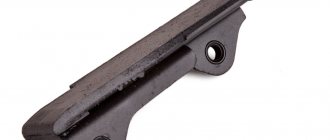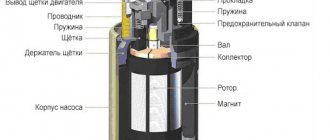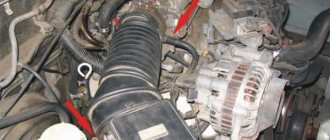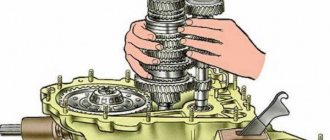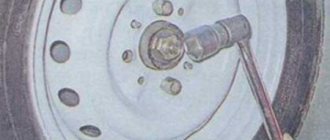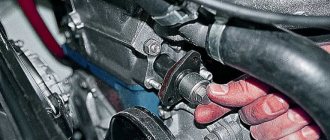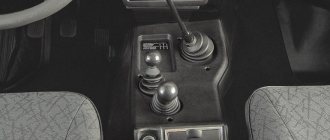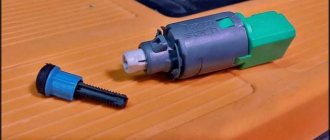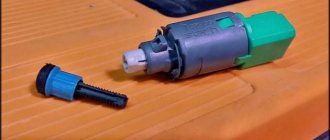Timing belt with chain drive on VAZ 2101
The “kopek”, like all other “classic” models, has a timing chain drive. The mechanism consists of a double-row metal chain and additional elements that ensure its tension and prevent vibrations. The well-coordinated operation of the motor directly depends on the integrity and serviceability of each part of the mechanism. The chain drive connects the crankshaft and camshaft and ensures their synchronous operation. When the shafts rotate, the pistons in the engine cylinders are set in motion, and the valves in the cylinder head (cylinder head) open and close in a timely manner.
The main elements of the VAZ 2101 timing drive are a chain, a damper, a shoe, a tensioner and sprockets
Tranquilizer
The damper performs the function of damping circuit vibrations. Without it, the chain may jump or fly off the sprockets of the timing mechanism. If the damper breaks down, the drive may simply break off. Such a nuisance is possible at high engine speeds. If the chain breaks, the pistons and valves are damaged, requiring expensive repairs. Therefore, the condition of the damper must be monitored and replaced in a timely manner. The part is a durable metal plate with special holes for fastening.
The chain damper dampens its vibrations when the engine is running.
Opposite the damper there is a shoe, which is also responsible for calming and tensioning the chain. It is made of a special polymer material, which gives the part high wear resistance.
The tensioner shoe is responsible for tensioning the chain and damping vibrations together with the damper
Tensioner
The “penny” chain drive tensioner prevents the chain from loosening when the motor is running. The element comes in several types:
- auto;
- mechanical;
- hydraulic.
Automatic tensioners began to be produced recently, but with regard to this part, it is already possible to note the pros and cons. The main positive point is that there is no need to make periodic adjustments, i.e. the drive is constantly in tension. The disadvantages include fairly quick failure and high cost of the part. In addition, based on reviews from car enthusiasts, the auto tensioner does not tension the chain very well.
The operation of hydraulic devices is based on the supply of oil under pressure from the engine lubrication system. With this design, the driver does not need to worry about periodically tightening the chain. However, over time, the part may malfunction, which manifests itself in the form of jamming of the mechanism.
The VAZ classic uses a mechanical tensioner. The part has a significant drawback: over time, it becomes clogged with small particles, the plunger jams and the device loses its ability to produce tension.
The chain tensioner is designed to keep the chain taut at all times.
Chain
One of the key elements of the timing chain drive is the chain itself, made of metal and having a certain number of links: on the VAZ 2101 there are 114 of them. Compared to a belt drive, the chain is more reliable and has a longer service life.
The chain is considered a more reliable element compared to the belt
Depending on the quality of the chain and the operating conditions of the vehicle, it is replaced every 60–100 thousand km. There are cases that a part lasts for 200 thousand km, but it’s hardly worth the risk, because a broken chain will result in a much more expensive repair than its timely replacement.
The chain is tightened every 10 thousand km, even in the absence of signs indicating sagging.
How to replace the timing chain on a VAZ 2101-VAZ 2107?
Removal: 1) First, remove the cylinder head cover. (For information on how to remove the cylinder head cover, read this article, point “1-10”)
2) Now turn the crank until the mark on the camshaft sprocket aligns with the mark on the housing.
Note! The mark on the crankshaft will also have to match the mark on the camshaft cover!
3) Next, bend the lock washer of the camshaft sprocket bolt.
4) Then engage fourth gear and put the car on the handbrake.
5) Next, loosen the camshaft sprocket bolt.
6) Then remove the chain guide from the engine. (For information on how to remove the chain guide, read “in this article”)
7) Then remove the chain tensioner shoe from the engine. (For information on how to remove the chain tensioner shoe, read “in this article”)
 Next, bend back the lock washer, which is located on the bolt securing the auxiliary units sprocket.
Next, bend back the lock washer, which is located on the bolt securing the auxiliary units sprocket.
9) Now unscrew the bolt itself that secures the accessory sprocket.
10) Then remove the accessory sprocket.
Note! After removing the sprocket, do not turn the drive shaft, because this may disrupt the initial ignition setting! (see photo at the very bottom of the article, in the “For Beginners!” section)
11) Next, completely unscrew the stop pin.
12) Next, completely unscrew the bolt that secures the camshaft sprocket.
13) Then lift the chain and remove the camshaft sprocket.
14) Then lower the chain deeply down, carefully removing it from all the sprockets.
Note! To remove the timing chain, you do not need to remove the crankshaft sprocket!
15) After all the operations performed, check whether the mark on the crankshaft sprocket matches the mark on the cylinder block.
Note! If the marks do not match, turn the crankshaft until they align!
Installation: 1) First put a new chain on the crankshaft sprocket.
2) Then put the chain on the sprocket of the auxiliary units.
3) Next, install the auxiliary units sprocket onto the drive shaft, while tightening the sprocket mounting bolt.
4) Next, hook the chain.
5) And then lift the chain up to the installation location of the camshaft sprocket.
6) Then put the chain on the camshaft sprocket, and only then install the sprocket in place.
7) Next, check that all marks match and tighten the timing chain. (How to check the coincidence of the marks, see the article: “Installing the piston of the fourth cylinder at TDC - Top Dead Center”) (And about how to tension the chain, read “in this article”)
Note! If you don’t understand how to tension the chain, then at the very bottom, watch the video on how to properly install the chain and how to tension it!
 Then tighten the camshaft sprocket bolt.
Then tighten the camshaft sprocket bolt.
9) Then install the chain guide in place in the reverse order of removing it.
10) Then reinstall the chain tensioner shoe in reverse order.
11) Next, install the stop pin in place.
12) Now put the gear in neutral and turn the crankshaft three turns in the direction of its rotation.
13) Check that all marks on the sprockets match.
Note! If the marks do not match, install the chain again and correct the situation!
14) If all the marks match, then: 1. Tighten the chain tensioner cap nut. 2. Shift into gear. 3. Tighten all sprocket bolts. 4. Install all remaining parts in the reverse order of removal.
Important! 1) When working in a ditch, place bricks under the wheels of the car to prevent the car from rolling away! 2) If you are unable to remove the auxiliary units sprocket, then try moving it using a mounting blade and then remove the sprocket!
For newbies! Question: Where is the accessory drive shaft located? Answer:
Additional video: If you don’t understand how to install a chain on a car, then watch a short video that explains everything in detail with the engine removed from the car.
Chain mechanism fault detection
The timing drive, equipped with a chain, is structurally located inside the engine. To determine the condition of the parts of this mechanism, it is necessary to partially disassemble the motor. The fact that there are problems with the chain or drive elements is indicated by characteristic signs.
The chain is noisy
A circuit can have different types of noise:
- noise under load;
- knocking on a warm engine;
- extraneous sounds when cold;
- constant noise with a metallic character.
If the motor begins to make sounds that are uncharacteristic of its normal operation, it is necessary to find out as soon as possible what problems have arisen with the chain drive and eliminate them. If this is not done, wear on the timing drive elements will increase, which can lead to costly repairs.
Video: chain knocking in a VAZ “classic” engine
Timing drive components may fail prematurely for the following reasons:
- the use of oil not specified by the car factory, or its untimely replacement;
- use of low-quality parts;
- low lubricant pressure in the engine;
- failure to comply with engine maintenance regulations;
- low quality of repairs.
Often the chain is noisy due to stretching or problems with the tensioner. Attempts to tighten it turn out to be useless, and the engine sounds like a diesel engine. The sound most often appears on a cold engine when idling.
The timing chain stretches over time, so it needs to be periodically tightened or replaced
Jumped the chain
With high mileage of the vehicle, the timing chain stretches. As a result, it can simply jump to other teeth of the camshaft or crankshaft gears. This problem may occur when the timing drive parts are damaged. If the chain jumps by at least one tooth, the ignition is greatly shifted and engine operation becomes unstable (sneezes, shoots, etc.). To fix the problem, you will need to check the integrity of the parts, and if damage is detected, make repairs.
VAZ 2107 TIMING CHAIN DRIVE - DESCRIPTION
The VAZ 2107 timing chain transmission has a long service life, but someday it’s time to replace it. The need for this arises as a result of stretching of the links, when the chain tensioner can no longer cope with the functions assigned to it. In addition, the parts responsible for the normal operation of the timing drive also wear out over time.
The main elements of the VAZ 2107 timing drive are a chain, a damper, a shoe, a tensioner and sprockets
SOOTHER
In the chain drive of the VAZ 2107 gas distribution mechanism, a damper is used to dampen jerks and vibrations of the chain. Without this part, as the vibration amplitude increases, the chain may fly off the gears or break completely. A chain transmission break is most likely at maximum crankshaft speed, which happens instantly. At the moment of a break, the intake and exhaust valves fail. After such damage, the engine will at best require a major overhaul.
The chain damper is designed to dampen vibrations of the chain drive during engine operation.
By its design, the damper is a plate made of high-carbon steel with two holes for fastening. Another element that is simultaneously responsible for calming and tensioning the chain is the shoe. Its rubbing surface is made of high-strength polymer material.
The tensioner shoe provides chain tension, eliminating sagging
TENSIONER
Based on the name, you can understand that the device is designed to prevent sagging of the timing chain while the engine is running. There are several types of such mechanisms:
- automatic;
- mechanical;
- hydraulic.
Automatic tensioners appeared not so long ago, but have already managed to show their positive and negative sides. The main advantage of the product is that there is no need to periodically adjust the chain tension, since the mechanism keeps it constantly taut. The disadvantages of the auto tensioner include quick failure, high cost, and poor tension, as evidenced by reviews from some car owners.
Hydraulic tensioners operate as a result of the action of oil under pressure, which is supplied from the engine lubrication system. This design does not require intervention from the driver in terms of adjusting the chain drive, but the mechanism can sometimes jam, which negates all its advantages.
The most common tensioner is mechanical. However, it has a significant drawback: the product becomes clogged with small particles, as a result of which the plunger jams and the mechanism is unable to perform its functions during tension adjustment.
The tensioner provides chain tension and allows for adjustments when needed.
CHAIN
The timing chain in the VAZ 2107 engine is designed to connect the crankshaft and camshaft: they have gears on which the chain is put. After starting the power unit, synchronous rotation of the indicated shafts is ensured through a chain transmission. If synchronization is disrupted for any reason, the timing mechanism malfunctions, resulting in the stable operation of the engine being disrupted. In such a situation, power failures, deterioration in dynamics, and increased fuel consumption are observed.
The timing chain in the VAZ 2107 engine is designed to connect the crankshaft and camshaft
As the vehicle is used, the chain stretches as high loads are placed on it. This indicates the need for periodic adjustment. Otherwise, the sagging will lead to the links on the gears jumping, which will disrupt the operation of the power unit. To prevent this from happening, the factory recommends adjusting the chain tension every 10 thousand km. mileage
Installing the chain by marks
The need to install marks on the timing mechanism may arise during the repair process or when the chain is severely stretched. If the marks do not match, the stable operation of the motor is disrupted due to a phase shift. In this case, an adjustment is required. The work is carried out with the following tools:
- Screwdriver Set;
- key for rotating the crankshaft;
- a set of keys.
To install the chain according to the marks, you will need a standard garage tool kit.
We carry out the procedure according to the following instructions:
- We dismantle the air filter box and the valve cover with the seal by unscrewing the fasteners.
- Loosen the tensioner clamp, press the screwdriver against the shoe and tighten the nut.
- Using a 38 mm wrench or a crank, turn the crankshaft until the marks on its pulley and the timing cover match, and the mark on the camshaft sprocket should be located opposite the protrusion cast on the body.
- If any of the marks do not coincide, turn on the fourth speed and unbend the lock washer on the camshaft sprocket.
- We unscrew the bolt and remove the gear.
- Remove the chain from the sprocket and set the desired position (step 3). After installing the marks, we perform reverse assembly.
You can turn the crankshaft with a 38 mm spanner.
Video: how to set timing marks on classic Zhiguli cars
Adjusting chain tension
The need to tighten the chain may be necessary in different situations:
- engine repair;
- replacing the chain drive;
- chain stretching.
To work you will need the following tools:
- 13 and 38 mm keys;
- flat screwdriver;
- pliers.
Tensioning the chain consists of several steps:
- We place the car on a flat surface, turn on neutral, placing stops under the wheels.
- We unscrew the chain tensioner clamp, and a characteristic click will be heard.
- Use a 38 mm wrench to rotate the crankshaft, making several revolutions.
- Stop rotation at maximum force and tighten the tensioner nut.
If the valve cover is removed, you can determine the tension of the chain by pressing it with a screwdriver . If the chain is tensioned normally, it will be stiff.
The chain tension with the valve cover removed can be checked with a screwdriver.
